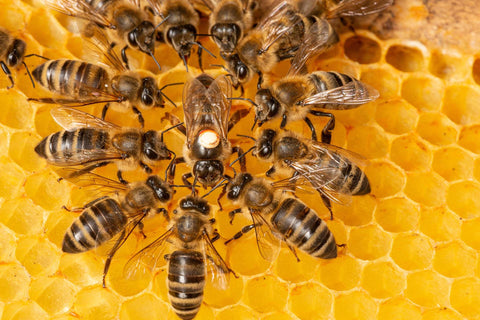As you would guess the queen bee is a crucial component in the hive. Queens are the only bee that can lay eggs to keep up the population of the hive. A healthy queen can lay around 2,000 eggs a day which can end up being over a million throughout her life span.
A queen bee emits a pheromone that lets the hive know she is healthy and present. As she gets older she produces less of this pheromone and the workers begin preparing to make a new queen to replace her. This can also happen if she is unproductive and not laying enough eggs or has recently died.
The workers will select a few young larvae, typically ones under a day old to ensure they produce a large and healthy queen, then they will build a special cell for them. This cell is elongated and shaped similar to a peanut since the queen bee is the largest bee in the hive and requires a larger cell.
The workers feed the larvae exclusively royal jelly allowing the new queen bee's reproductive system to fully form. The only difference between a worker bee and a queen bee is that a worker bee will switched over to being fed 'bee bread', a mixture of royal jelly, honey, and nectar, a few days into the larvae stage while the queen's diet remains royal jelly throughout the entirety of her larvae stage.
The queen's cell is capped after she is ready to pupate. After about a week the queen will then chew her way out of her cell when she is ready to emerge. From egg to queen, it only takes around 16 days which is the shortest development time of any of the others in the hive.
A queen bee's stinger isn't barbed like the common worker bee so she can sting as many times as she pleases. This comes in handy when she first emerges from the cell. Because there have been many queen cells prepared to replace the old queen and only one can supersede, the young queens fight to the death to determine who will take her place.
The newly emerged queens will call out to each other and will congregate together in order to fight to the death. The first one to emerge has the advantage since she will then go to all the other queen cells and sting through them to kill the other unmerged queens. The last one remaining supersedes the old queen and takes over the hive.
The queen then prepares for her nuptial flight where she will leave the hive and mate with various drones so she can begin laying eggs. It takes a few days as she gains the strength to fly and let her reproductive system fully develop before taking her flight.
She will fly out of the hive, sometimes over the span of multiple days, to drone congregating areas and the strongest and fastest drones will catch her mid flight and mate with her. The drones then fall to the ground dead since during the process part of their abdomen is ripped out.
The queen will mate with many different drones to ensure that there is enough diversity for the continuation and health of the hive. She collects all the sperm she needs for the rest of her life during these flights and stores it in her spermatheca.
Once she returns to the hive she will never leave again unless she decides to swarm towards the end of her life. The worker bees will work tirelessly to take care of everything she needs. They dispose of her waste, clean her, feed her, even digest her food before giving it to her so she can stay focused on her sole responsibility to lay eggs for the hive.
The queen can determine the sex of the egg as she lays it. If she fertilizes the egg it becomes a female worker bee, if she doesn't it will become a male drone. She will crawl around the comb and search for clean cells to lay her eggs in and does so until it is time to be replaced by another queen.




